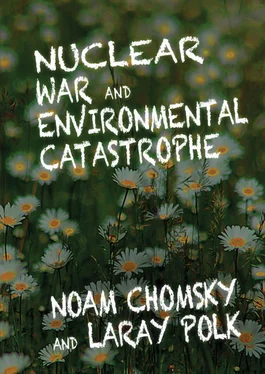It came up again in May 2010. Egypt is now speaking for the Non-Aligned Movement, 118 countries, they’re this year’s representative, and they pressed pretty hard for a move in that direction. The pressure was so strong that the United States accepted it in principle and claims to be committed to it, but Hillary Clinton said the time’s “not ripe for establishing the zone.” [54] Louis Charbonneau, “U.S. and Other Big Powers Back Mideast Nuclear Arms Ban,” Reuters, May 5, 2010.
And the administration just endorsed Israel’s position, essentially saying, “Yes, but only after a comprehensive peace agreement in the region,” which the US and Israel can delay indefinitely. So, that’s basically saying, “it’s fine, but it’s never going to happen.” And this is barely ever reported, so nobody knows about it. Just as almost nobody knows about Obama informing India and Israel that the resolutions don’t apply to them. All of this just increases the risk of nuclear war.
It’s more than that actually. You know, the threats against Iran are nontrivial and that, of course, induce them to move toward nuclear weapons as a deterrent. Obama in particular has strongly increased the offensive capacity that the US has on the island of Diego Garcia, which is a major military base they use for bombing the Middle East and Central Asia. [55] Diego Garcia is home to one of five monitoring stations used to operate NAVSTAR GPS. Other terrestrial locations in the network include Hawaii, Colorado, Ascension Island, and Kwajalein Atoll. Implemented by the Department of Defense in 1973, NAVSTAR GPS is a radio-navigation system that utilizes satellite to ground triangulation to provide precise geospatial coordinates for both military and civilian use (i.e., vehicle and cellular map locator). The system is usually referred to in its shortened form, GPS. “The Global Positioning System,” National Academy of Sciences, 1997. The permanent eviction of the inhabitants of Diego Garcia (ca. 1973) to make way for US military operations is a continued issue of contention. Recent news of the UK government’s plan to create a marine protection area has further inflamed the issue; a leaked diplomatic cable confirmed suspicions it was a move to deny Chagossians the right of return: “BIOT’s former inhabitants would find it difficult, if not impossible, to pursue their claim for resettlement on the islands if the entire Chagos Archipelago were a marine reserve.” WikiLeaks , s.v. “Cable 09LONDON1156, HMG Floats Proposal for Marine Reserve Covering,” May 2009. On GPS and Kwajalein Atoll, see Vltchek, note 1, chap. 3.
In December 2009, the navy dispatched a submarine tender for nuclear submarines in Diego Garcia. Presumably they were already there, but this is going to expand their capacity, and they certainly have the capacity to attack Iran with nuclear weapons. And he also sharply increased the development of deep-penetration bombs, a program that mostly languished under the Bush administration. As soon as Obama came in, he accelerated it, and it was quietly announced—but I think not reported here—that they put a couple of hundred of them in Diego Garcia. That’s all aimed at Iran. Those are all pretty serious threats. [56] In 2009 the Pentagon sent an “urgent operational need” funding request to Congress to fast-track the development and testing of the Massive Ordnance Penetrator (MOP), a thirty-thousand-pound bunker-busting bomb designed to hit underground targets. It was listed inside a ninety-three-page “reprogramming” request with hundreds of other items, and approved with little fanfare. Jonathan Karl, “Is the U.S. Preparing to Bomb Iran?,” ABC News, October 6, 2009. On shipment of bunker-busting bombs to Diego Garcia, see Rob Edwards, “Final Destination Iran?,” Herald (Scotland), March 14, 2010.
Actually, the question of the Iranian threat is quite interesting. It’s discussed as if that’s the major issue of the current era. And not just in the United States, Britain too. This is “the year of Iran,” Iran is the major threat, the major policy issue. It does raise the question: What’s the Iranian threat? That’s never seriously discussed, but there is an authoritative answer, which isn’t reported. The authoritative answer was given by the Pentagon and intelligence in April 2010; they have an annual submission to Congress on the global security system, and of course discussed Iran. [57] John J. Kruzel, “Report to Congress Outlines Iranian Threats,” AFPS (Defense.gov), April 20, 2010.
They made it very clear that the threat is not military. They said Iran has very low military spending even by the standards of the region; their strategic doctrine is completely defensive, it’s designed to deter an invasion long enough to allow diplomacy to begin to operate; they have very little capacity to deploy force abroad. They say if Iran were developing nuclear capability, which is not the same as weapons, it would be part of the deterrent strategy, which is what most strategic analysts take for granted, so there’s no military threat. Nevertheless, they say it’s the most significant threat in the world. What is it? Well, that’s interesting. They’re trying to extend their influence in neighboring countries; that’s what’s called destabilizing. So if we invade their neighbors and occupy them, that’s stabilizing. Which is a standard assumption. It basically says, “Look, we own the world.” And if anybody doesn’t follow orders, they’re aggressive.
In fact, that’s going on with China right now. It’s been a kind of a hassle, also hasn’t been discussed much in the United States—but is discussed quite a lot in China, about control of the seas in China’s vicinity. Their navy is expanding, and that’s discussed here and described as a major threat. What they’re trying to do is to be able to control the waters nearby China—the South China Sea, Yellow Sea, and so on—and that’s described here as aggressive intent. The Pentagon just released a report on the dangers of China. Their military budget is increasing; it’s now one-fifth what the US spends in Iraq and Afghanistan, which is of course a fraction of the military budget. Not long ago, the US was conducting naval exercises in the waters off China. China was protesting particularly over the plans to send an advanced nuclear-powered aircraft carrier, the USS George Washington , into those waters, which, according to China, has the capacity to hit Beijing with nuclear weapons—and they didn’t like it. And the US formally responded by saying that China is being aggressive because they’re interfering with freedom of the seas. Then, if you look at the strategic analysis literature, they describe it as a classic security dilemma where two sides are in a confrontation. Each regards what it’s doing as essential to its security and regards the other side as threatening its security, and we’re supposed to take the threat seriously. So if China is trying to control waters off its coast, that’s aggression and it’s harming our security. That’s a classic security dilemma. You could just imagine if China were carrying out naval exercises in the Caribbean—in fact, in the mid-Pacific—it would be considered intolerable. That’s very much like Iran. The basic assumption is “We own the world,” and any exercise of sovereignty within our domains, which is most of the world, is aggression.
Is there any type of nuclear racism involved in these issues?
I think it would be the same if there were no nuclear weapons. I mean, it goes back to long-term planning assumptions, and I don’t really think it’s racism. Let’s take a concrete case. We have a lot of internal documents now, some interesting ones from the Nixon years. Nixon and Kissinger, when they were planning to overthrow the government of Chile in 1973, their position was that this government’s intolerable, it’s exercising its sovereignty, it’s a threat to us, so it has to go. [58] See National Security Archive Electronic Briefing Book No. 255, “New Kissinger ‘Telcons’ Reveal Chile Plotting at Highest Levels of U.S. Government.”
It’s what Kissinger called a virus that might spread contagion elsewhere, maybe into southern Europe—not that Chile would attack southern Europe—but that a successful, social democratic parliamentary system would send the wrong message to Spain and Italy. They might be inclined to try the same, it would mean its contagion would spread and the system falls apart. And they understood that, in fact stated that, if we can’t control Latin America, how are we going to control the rest of the world? We at least have to control Latin America. There was some concern—which was mostly meaningless, but it was there—about a Soviet penetration into Latin America, and they recognized that if Europe gets more involved in Latin America, that would tend to deter any Soviet penetration, but they concluded the US couldn’t allow that because it would interfere with US dominance of the region. So, it’s not racist. It’s a matter of dominance.
Читать дальше












